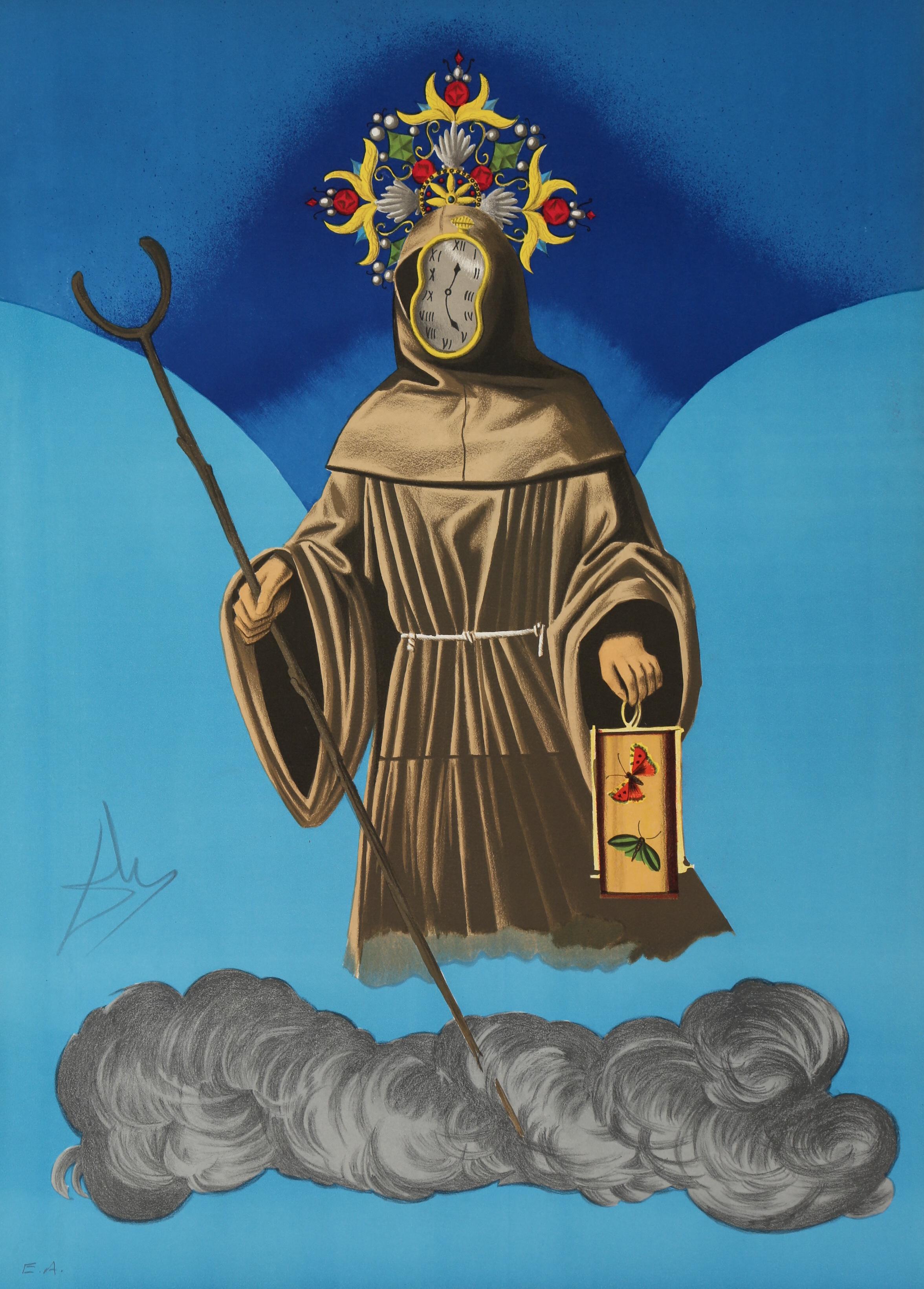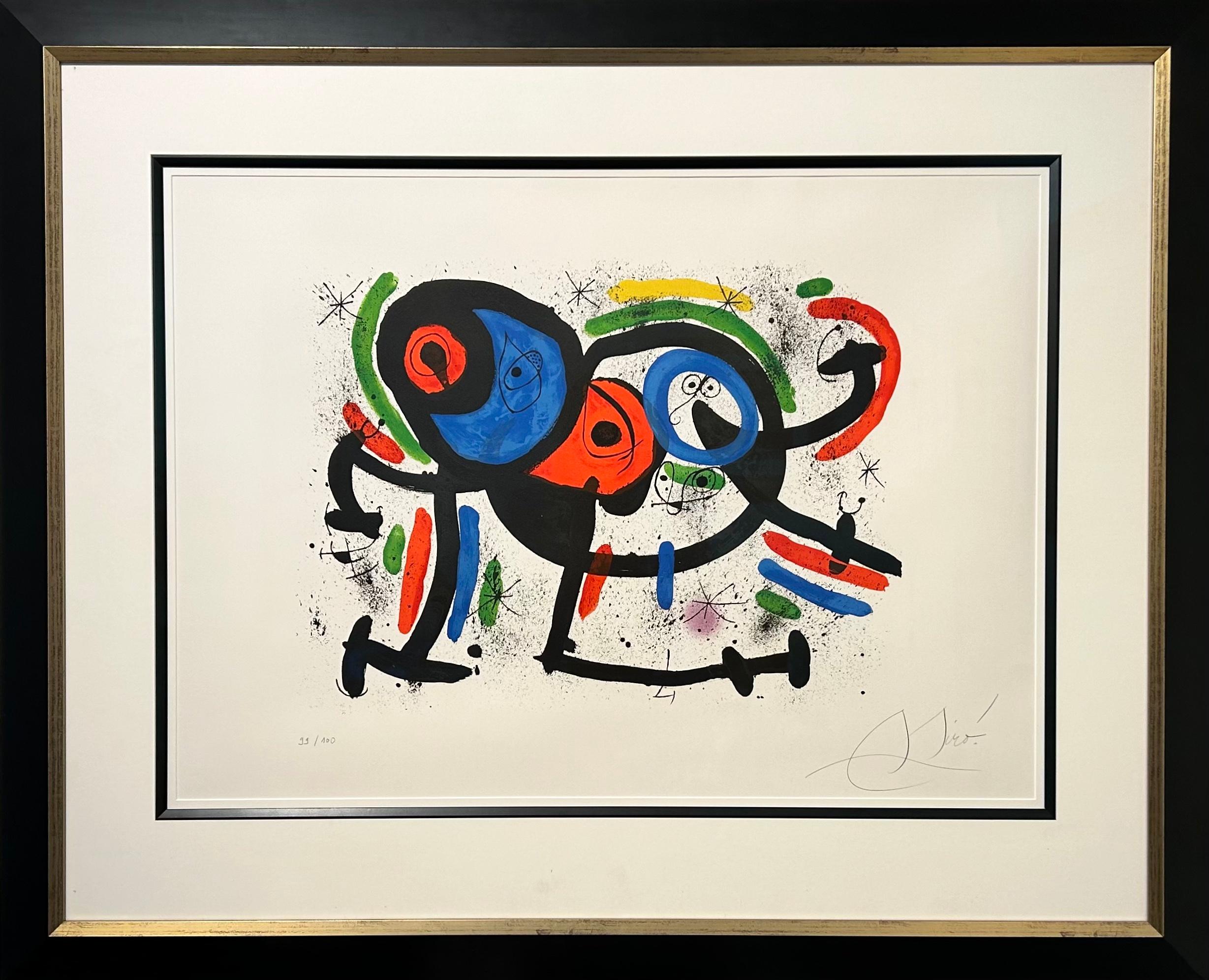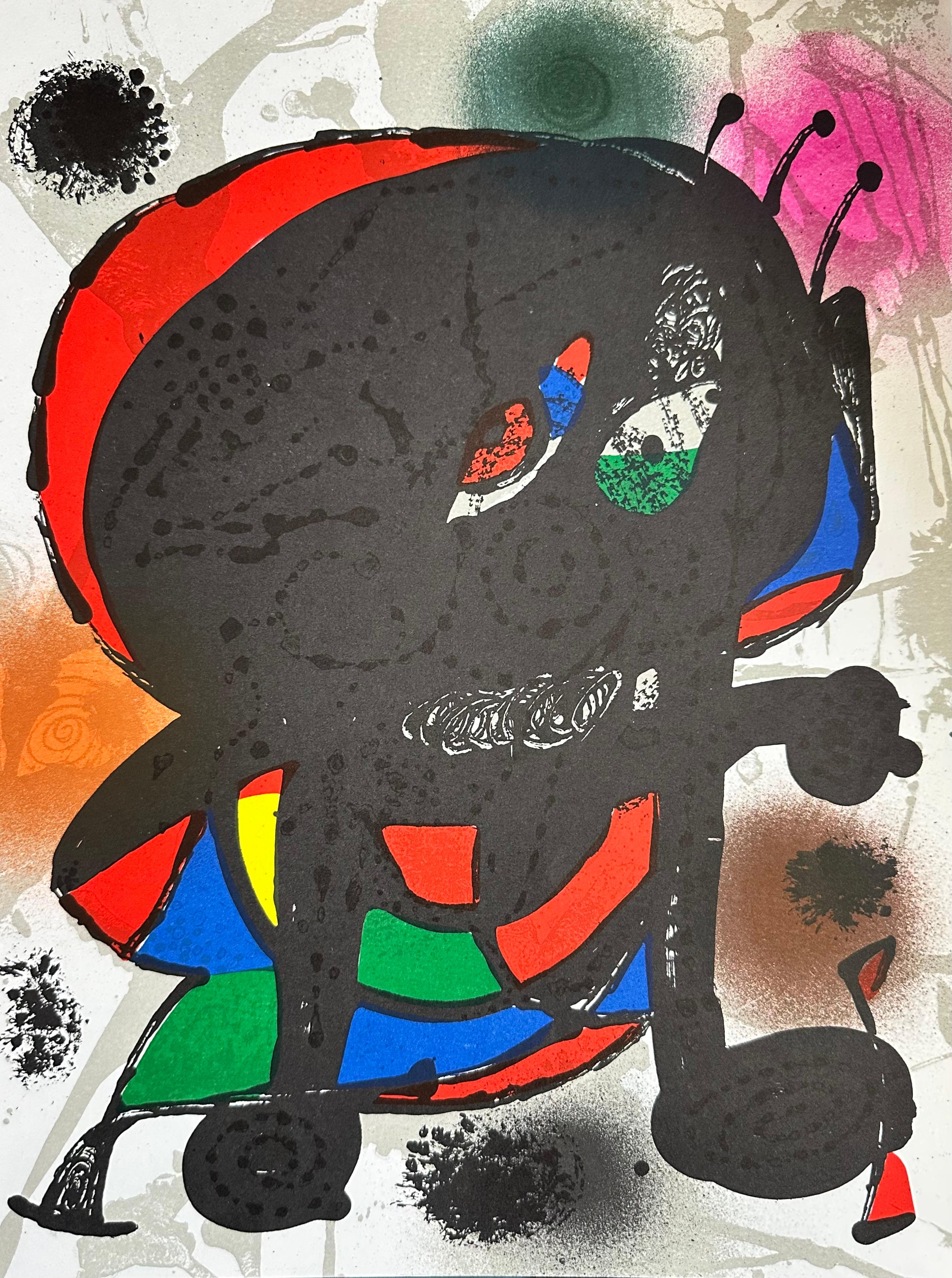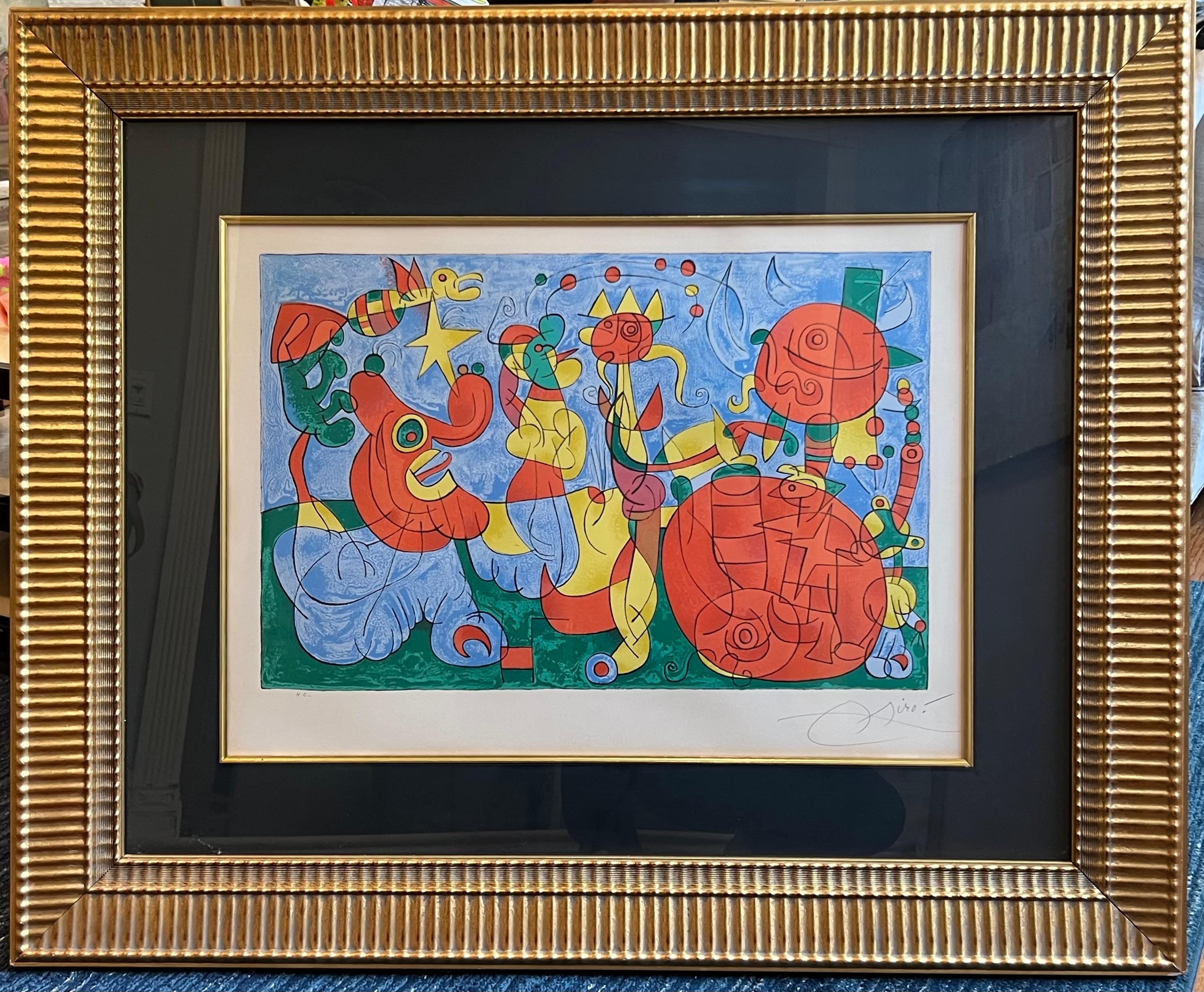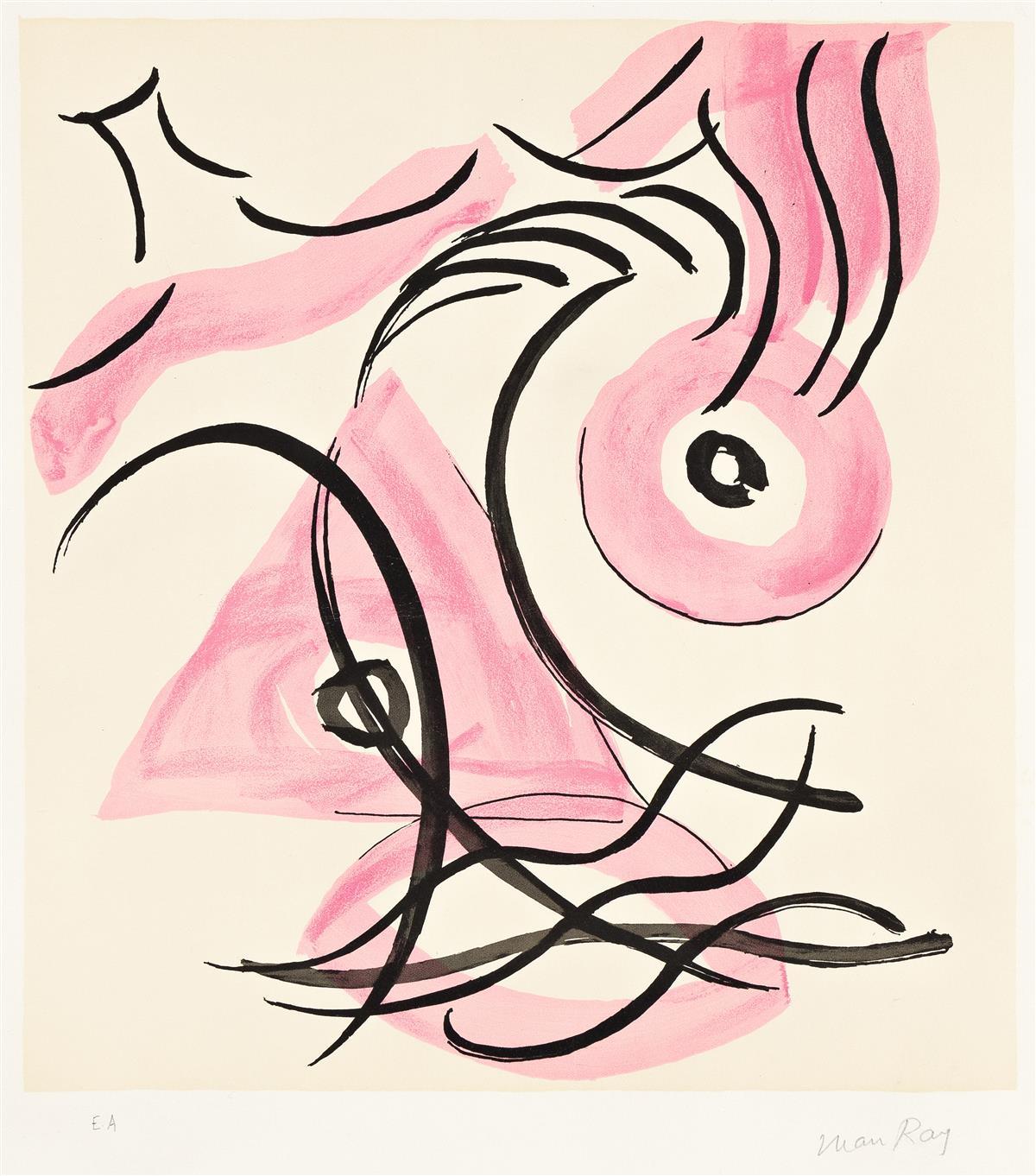Items Similar to Joan Miro Vintage Surrealist Lithograph Poster Adrien Maeght Marlborough Gallery
Want more images or videos?
Request additional images or videos from the seller
1 of 15
Joan Miro Vintage Surrealist Lithograph Poster Adrien Maeght Marlborough Gallery1966
1966
About the Item
Joan Miro, Spanish (1893–1983)
Vintage lithograph poster from Arte Paris for a Marlborough Gallery show in London, England
Signed in the plate
Recent Paintings 1945-1963 Exhibition
Date: 1966
Size: 29.25 in. x 19.75 inches
Publisher: Arte Adrien Maeght
Reference: Miro, Lithographs III, Maeght Publisher
Joan Miro Catalan Surrealist. Born in Barcelona, Spain in 1893, He mixed popular, vanguard, and folk art forms, splicing together previously unattached traditions. He went to art school in Barcelona where he was introduced to French Romantic and social Realist art, and then Impressionism and Post Impressionism. He was influenced by artists such as Cezanne, Van Gogh, Matisse, and Picasso. From Matisse he learned how large areas of color and pattern could flatten and control his picture plane. From Picasso he gained a feel for cubism. Son of a jewelry maker, Miro quickly revealed his love of painting, Before he went to Paris for the first time (1919), he had already met Francis Picabia, and had read a great deal of French poetry and avant garde magazines. In 1920, he decided to settle in the French capital, Paris, where het met Pablo Picasso, Maurice Raynal, Reverdy, Tristan Tzara and Max Jacob. Around 1923, after having painted La Masia (1921. 1922), which was the culmination of his period of detailed realism, he changed the way he painted, turning to surrealism and beginning, as of 1924, a strong friendship with Andre Breton, Louis Aragon and Paul Eluard. In 1926, he worked for the first time in the world of the theater and dance, creating with Max Ernst the scenography of Romeo and Juliette for the Russian Ballet. Other work followed, such as Jeux d ́enfants (1932) and Mori el Merma (1978). In 1930, he began to enjoy international recognition, which had started with the success of his 1925 exhibition in Paris, with the first showings of his work in the United States and Brussels. These were followed by his remarkable retrospectives at the Museum of Modern Art in New York (1941 and 1952), Brasilea (1952), Los Angeles (1959). Influenced by the impact of the Spanish and European wars, he did the series of paintings called Constellations, which meant a step forward in his constant broaching of new pictorial problems, as well as the beginning of a new, freer and more personal period. In 1947, he spent eight months in the United States. arches This was an important milestone in that it meant a definitive turn towards large format work, as evidenced by his mural at the Terrace Plaza Hotel in Cincinnati. He would later paint, among others, the mural at Harvard University (1951). Joan Miro ́s great creativity led him to work in and investigate fields of such diversity as signed etchings, hand thrown ceramics always at the side of Llorens Artigas sculpture and aubusson tapestry. Jean Miro won a number of prestigious prizes including First Prize from the Guggenheim Foundation in 1954 and the Carnegie Prize for Painting in 1967. One may view examples of Miro's works in the world's most prominent gallery museums, including: the Musee d'Art Moderne, France; the Museum of Modern
Art, New York; The Hermitage in St. Petersburg, U.S.S.R; The Metropolitan Museum of Art, New York; the Yale University Art Gallery, New Haven, Connecticut; the Philadelphia Museum of Art, Philadelphia, and many more. Miro was one of the greatest talents of Surrealism (along with Salvador Dali and Magritte) and a master of twentieth century painting. Miró died in Majorca, Spain, on December 25, 1983.
- Creation Year:1966
- Dimensions:Height: 29.75 in (75.57 cm)Width: 19.75 in (50.17 cm)
- Medium:
- Movement & Style:
- After:Joan Miró (1893 - 1983, Catalan)
- Period:
- Condition:good. minor wear. light edge wear and some wrinkling. should. show well matted and framed. please see photos.
- Gallery Location:Surfside, FL
- Reference Number:1stDibs: LU38211285312
About the Seller
4.9
Platinum Seller
These expertly vetted sellers are 1stDibs' most experienced sellers and are rated highest by our customers.
Established in 1995
1stDibs seller since 2014
1,550 sales on 1stDibs
Typical response time: 1 hour
- ShippingRetrieving quote...Ships From: Surfside, FL
- Return PolicyA return for this item may be initiated within 3 days of delivery.
More From This SellerView All
- Feminist Surrealist French Abstract Colorful Lithograph Print Myriam Bat YosefLocated in Surfside, FLMyriam Bat-Yosef Surrealist abstract lithograph print in colorful abstract shapes and shades Hand signed and dated 1971. sheet measures 9.25 X 9.25 inches ...Category
1970s Surrealist Abstract Prints
MaterialsLithograph
- Feminist Surrealist French Abstract Colorful Lithograph Print Myriam Bat YosefLocated in Surfside, FLMyriam Bat-Yosef Surrealist abstract lithograph print in colorful abstract shapes and shades Hand signed and dated 1971. sheet measures 9.25 X 9.25 inches The envelope and the Peter Buch poster is just for provenance and is not included in this sale. Myriam Bat-Yosef, whose real name is Marion Hellerman, born on January 31, 1931 in Berlin, Germany to a Jewish family from Lithuania, she is an Israeli-Icelandic artist who paints on papers, paintings, fabrics, objects and human beings for performances. Myriam Bat-Yosef currently lives and works in Paris. In 1933, her family fleeing the Nazi Holocaust, Miriam Bat-Yosef emigrates to Palestine and settles in Jaffa. In 1936, she suffers a family tragedy, her father, militant Zionist, is called to fight, still recovering from an operation of appendicitis. The incision will become infected, antibiotics did not exist yet, and her father will die in the hospital after 9 months of suffering. Myriam and her mother leave Palestine to live in Paris for three years. French is Myriam's first school language. In 1939, still fleeing Nazism, she returned to Palestine, leaving France by the last boat from Marseille. She moved to Tel Aviv with her mother, aunt and maternal grandmother. In 1940, she began attending the Academy of Fine Arts in Tel Aviv and took her name as an artist, Bat-Yosef, which means Joseph's daughter in Hebrew, as a tribute to her father. In 1946, Myriam graduated as a kindergarten teacher but wanted to be an artist. Her mother enrolled her in an evening school to prepare a diploma of art teacher. At 19, she performs two years of military service in Israel. In 1952, with a pension of $50 a month that her mother allocated, she went to study at the Beaux-Arts in Paris. To survive, she has several activities while studying. In 1955, she had her first solo exhibition, at the Israeli Club on Wagram Avenue in Paris. Many artists, such as Yaacov Agam, Yehuda Neiman Avigdor Arikha, Raffi Kaiser, Dani Karavan and sculptors Achiam and Shlomo Selinger attended the opening . In 1956, she enrolled at the School of Fine Arts in Florence. This is where she meets the painter Errô. They share an icy studio in winter. Myriam moves to Milan with friends. She organizes a joint exhibition with Erro, one room each, at the Montenapoleone gallery. Her works are admired by the sculptor Marino Marini and the painters Renato Birolli and Enrico Prampolini. Myriam and Erro exhibit in Rome, Milan, Florence and meet many personalities: Alain Jouffroy and his wife, the painter Manina, Roberto Matta and his wife Malitte, textile artist who was one of the founders of the Pompidou Center. Back in Paris, Myriam and Erro get married, which allows Myriam to avoid being called into the Israeli army during the Suez Canal War. In 1957, Myriam and her husband went to Iceland. Myriam works in a chocolate factory. Having enough money, she starts producing art again. She exhibited in Reykjavik's first art gallery. She meets the artist Sigridur Bjornsdottir, married to the Swiss painter Dieter Roth . In 1958, Myriam and her husband leave for Israel. They exhibit in Germany, then in Israel. Back in Paris, the couple became friends with artists of the surrealist movement, such as Victor Brauner, Hans Bellmer, the sculptor Philippe Hiquily, Liliane Lijn, future wife of Takis and photographer Nathalie Waag. Erro and Myriam have a daughter on March 15, 1960, named Tura, after the painter Cosmè Tura, but also close to the Icelandic Thora or the Hebrew Torah. Bat-Yosef’s complex trajectory throughout the 20th century is linked as much to the transnational history of what was for a time called the School of Paris as it is to a certain legacy of Surrealism. Her work features the same idea of resolving antinomies that also defined the spirit of surrealism, and is enhanced with her readings of the Kabbalah and her spiritual grounding in Taoism. However, while there are reasons for her approach to be associated with the process of the ready-made, it is important to consider the immediate intrication of these works with her practice of performance, during which the body itself is also painted – a feminist response to Yves Klein’s Anthropometries (1960) and an echo of the happenings which Jean-Jacques Lebel organised at the time in Paris. In 1963, Erró told Myriam that if she wants to be a painter, she can not be his wife. Myriam chose to be a painter and the couple divorced in 1964. Since that time, Myriam Bat-Yosef has exhibited in many countries: Europe, United States, Japan, etc. Although long in the shadows, the work of Myriam Bat-Yosef has been greeted by many artists and personalities: Anaïs Nin, Nancy Huston, André Pieyre of Mandiargues, José Pierre, René de Solier , Jacques Lacarrière, Alain Bosquet, Pierre Restany, Sarane Alexandrian and Surrealist André Breton who, after a visit to her studio, confided to having been intrigued by its phantasmagorical dimension. She was included in the book Pop Art and Beyond: Gender, Race, and Class in the Global Sixties by Mona Hadler and Kalliopi Minioudaki. Extract "World Citizen, Artist of the Pop Era Sarah Wilson; Why do we know so little of Myriam Bat-Yosef, the most important female Israeli artist of the Pop era? Issues of identity and sexuality feature constantly in her work. She exhibited internationally from Reykjavik to Tokyo; she had two shows at Arturo Schwarz’s famous Dada/surrealist gallery in Milan; she participated in feminist art events in Los Angeles. Above all, in 1971, she conceived Total Art, a Pop Gesamtkunstwerk inside and outside the Israel Museum, Jerusalem. Painter, performer, and installation artist, she was also a lover, wife, and mother. Of Lithuanian-Jewish descent, she was close to the family of philosopher Emmanuel Levinas. An émigré in Paris she would repudiate a national passport, participating in Garry Davis’s short-lived “World Citizens” movement. She continues the lineage of women surrealist artists: Valentine Hugo, Leonor Fini, Dorothea Tanning, Leonora Carrington, Unica Zürn, Jane Graverol, Toyen, Alice Rahon...Category
1970s Surrealist Abstract Prints
MaterialsLithograph
- Feminist Surrealist French Abstract Colorful Lithograph Print Myriam Bat YosefLocated in Surfside, FLMyriam Bat-Yosef Surrealist abstract lithograph print in colorful abstract shapes and shades Hand signed and dated 1971. sheet measures 9.25 X 9.25 inches The envelope and the Peter Buch poster is just for provenance and is not included in this sale. Myriam Bat-Yosef, whose real name is Marion Hellerman, born on January 31, 1931 in Berlin, Germany to a Jewish family from Lithuania, she is an Israeli-Icelandic artist who paints on papers, paintings, fabrics, objects and human beings for performances. Myriam Bat-Yosef currently lives and works in Paris. In 1933, her family fleeing the Nazi Holocaust, Miriam Bat-Yosef emigrates to Palestine and settles in Jaffa. In 1936, she suffers a family tragedy, her father, militant Zionist, is called to fight, still recovering from an operation of appendicitis. The incision will become infected, antibiotics did not exist yet, and her father will die in the hospital after 9 months of suffering. Myriam and her mother leave Palestine to live in Paris for three years. French is Myriam's first school language. In 1939, still fleeing Nazism, she returned to Palestine, leaving France by the last boat from Marseille. She moved to Tel Aviv with her mother, aunt and maternal grandmother. In 1940, she began attending the Academy of Fine Arts in Tel Aviv and took her name as an artist, Bat-Yosef, which means Joseph's daughter in Hebrew, as a tribute to her father. In 1946, Myriam graduated as a kindergarten teacher but wanted to be an artist. Her mother enrolled her in an evening school to prepare a diploma of art teacher. At 19, she performs two years of military service in Israel. In 1952, with a pension of $50 a month that her mother allocated, she went to study at the Beaux-Arts in Paris. To survive, she has several activities while studying. In 1955, she had her first solo exhibition, at the Israeli Club on Wagram Avenue in Paris. Many artists, such as Yaacov Agam, Yehuda Neiman Avigdor Arikha, Raffi Kaiser, Dani Karavan and sculptors Achiam and Shlomo Selinger attended the opening . In 1956, she enrolled at the School of Fine Arts in Florence. This is where she meets the painter Errô. They share an icy studio in winter. Myriam moves to Milan with friends. She organizes a joint exhibition with Erro, one room each, at the Montenapoleone gallery. Her works are admired by the sculptor Marino Marini and the painters Renato Birolli and Enrico Prampolini. Myriam and Erro exhibit in Rome, Milan, Florence and meet many personalities: Alain Jouffroy and his wife, the painter Manina, Roberto Matta and his wife Malitte, textile artist who was one of the founders of the Pompidou Center. Back in Paris, Myriam and Erro get married, which allows Myriam to avoid being called into the Israeli army during the Suez Canal War. In 1957, Myriam and her husband went to Iceland. Myriam works in a chocolate factory. Having enough money, she starts producing art again. She exhibited in Reykjavik's first art gallery. She meets the artist Sigridur Bjornsdottir, married to the Swiss painter Dieter Roth . In 1958, Myriam and her husband leave for Israel. They exhibit in Germany, then in Israel. Back in Paris, the couple became friends with artists of the surrealist movement, such as Victor Brauner, Hans Bellmer, the sculptor Philippe Hiquily, Liliane Lijn, future wife of Takis and photographer Nathalie Waag. Erro and Myriam have a daughter on March 15, 1960, named Tura, after the painter Cosmè Tura, but also close to the Icelandic Thora or the Hebrew Torah. Bat-Yosef’s complex trajectory throughout the 20th century is linked as much to the transnational history of what was for a time called the School of Paris as it is to a certain legacy of Surrealism. Her work features the same idea of resolving antinomies that also defined the spirit of surrealism, and is enhanced with her readings of the Kabbalah and her spiritual grounding in Taoism. However, while there are reasons for her approach to be associated with the process of the ready-made, it is important to consider the immediate intrication of these works with her practice of performance, during which the body itself is also painted – a feminist response to Yves Klein’s Anthropometries (1960) and an echo of the happenings which Jean-Jacques Lebel organised at the time in Paris. In 1963, Erró told Myriam that if she wants to be a painter, she can not be his wife. Myriam chose to be a painter and the couple divorced in 1964. Since that time, Myriam Bat-Yosef has exhibited in many countries: Europe, United States, Japan, etc. Although long in the shadows, the work of Myriam Bat-Yosef has been greeted by many artists and personalities: Anaïs Nin, Nancy Huston, André Pieyre of Mandiargues, José Pierre, René de Solier , Jacques Lacarrière, Alain Bosquet, Pierre Restany, Sarane Alexandrian and Surrealist André Breton who, after a visit to her studio, confided to having been intrigued by its phantasmagorical dimension. She was included in the book Pop Art and Beyond: Gender, Race, and Class in the Global Sixties by Mona Hadler and Kalliopi Minioudaki. Extract "World Citizen, Artist of the Pop Era Sarah Wilson; Why do we know so little of Myriam Bat-Yosef, the most important female Israeli artist of the Pop era? Issues of identity and sexuality feature constantly in her work. She exhibited internationally from Reykjavik to Tokyo; she had two shows at Arturo Schwarz’s famous Dada/surrealist gallery in Milan; she participated in feminist art events in Los Angeles. Above all, in 1971, she conceived Total Art, a Pop Gesamtkunstwerk inside and outside the Israel Museum, Jerusalem. Painter, performer, and installation artist, she was also a lover, wife, and mother. Of Lithuanian-Jewish descent, she was close to the family of philosopher Emmanuel Levinas. An émigré in Paris she would repudiate a national passport, participating in Garry Davis’s short-lived “World Citizens” movement. She continues the lineage of women surrealist artists: Valentine Hugo, Leonor Fini, Dorothea Tanning, Leonora Carrington, Unica Zürn, Jane Graverol, Toyen, Alice Rahon...Category
1970s Surrealist Abstract Prints
MaterialsLithograph
- Feminist Surrealist French Abstract Colorful Lithograph Print Myriam Bat YosefLocated in Surfside, FLMyriam Bat-Yosef Surrealist abstract lithograph print in colorful abstract shapes and shades Hand signed and dated 1971. sheet measures 9.25 X 9.25 inches ...Category
1970s Surrealist Abstract Prints
MaterialsLithograph
- 1970s Modernist Swiss Colorful Surrealism Signed Dada Lithograph Andre ThomkinsBy André ThomkinsLocated in Surfside, FLThis one is titled "Walk in a Broken Lake" and depicts a surreal figure of a robed woman walking in an abstract landscape in yellow, green, red and blue with a Salvador Dali esque quality about it. Published by Edition Hansjörg Mayer, Stuttgart They published concrete poetry and art books by Mark Boyle, Richard Hamilton, Dorothy Iannone, John Latham, Tom Phillips, Dieter Roth, André Thompkins and Emmett Williams, to name just a few. André Thomkins (1930 - 1985) was a Swiss painter, illustrator, and poet. He attended art-school, taught by Max von Moos, 1947 – 1949 and the Académie de la Grande Chaumière, Paris, France, 1950. From 1952, he lived in Germany and taught at the Kunstakademie Düsseldorf between 1971 and 1973. Thomkins painted and drew ironic and fantastic pictures influenced by surrealism and dadaism. Together with Dieter Roth and Daniel Spoerri he prepared works of Eat Art. He also was a writer of palindromes. His friends and collaborators included Daniel Spoerri, Dieter Roth, George Brecht, Richard Hamilton and Karl Gerstner, Thomkins gained a reputation as an ‘artist’s artist’, and is considered one of the most important Swiss artists of the second half of the twentieth century.He died in 1985. His work is currently represented by Hauser & Wirth Zurich, Switzerland. Select group exhibitions: 2018 Kunsthalle Krems, 'Pablo Picasso. Arshile Gorky, Andy Warhol. Sculptures and Works on Paper. Hubert Looser Collection', Krems, Austria 2017 Kunsthandel Wolfgang Werner, 'Martin Barré, Karl Otto Götz, Ernst Wilhelm Nay, André Thomkins', Berlin, Germany 2013 Fabian & Claude Walter Galerie, 'Schweizer Avantgarde Kunst nach 1940', Zurich, Switzerland 2009 The Modern Institute, 'Thomas Houseago, Dieter Roth, Andre Thomkins', Glasgow, England Museum of Modern Art, 'Compass in Hand: Selections from the Judith Rothschild Collection', NYC 2004 Kunsthandel Wolfgang Werner, 'Arman, Baumeister, Götz, Graubner, Tàpies, Thomkins', Berlin, Germany 1994 Kunstmuseum Solothurn, 'Eine Schenkung. Grafik von Eduardo Chillida, Antoni Tàpies, Alexander Calder, Jean Dubuffet, Ben Nicholson, Giacometti, Tinguely, Thomkins', Solothurn, Switzerland 1992 Galerie Littmann, Tinguely zu Ehren. A Tribute to Jean Tinguely. Hommage à Tinguely, Basel, 1988 Museum Ludwig, 'Uebrigens sterben immer die anderen. Marcel Duchamp und die Avantgarde seit 1950', Cologne, Germany 1987 Aargauer Kunsthaus, 'Otto Grimm. Marc-Antoine Fehr. Christoph Gredinger', Aarau, Switzerland Cercle Municipal, 'Art contemporain suisse. Collection de la Banque du Gothard', Luxembourg, 1985 Centre national d'art et de culture Georges Pompidou, 'Livres d'artistes', Paris, France Rathaus, 'Claude Sandoz – Hans Schärer...Category
1970s Surrealist Figurative Prints
MaterialsLithograph, Offset
- 1970s Modernist Swiss Colorful Surrealism Signed Dada Lithograph Andre ThomkinsBy André ThomkinsLocated in Surfside, FLThis one is titled "Halemaid" and depicts a surreal figure of a robed woman in yellow red and blue with a Salvador Dali esque quality about it. Published by Edition Hansjörg Mayer, Stuttgart They published concrete poetry and art books by Mark Boyle, Richard Hamilton, Dorothy Iannone, John Latham, Tom Phillips, Dieter Roth, André Thompkins and Emmett Williams, to name just a few. André Thomkins (1930 - 1985) was a Swiss painter, illustrator, and poet. He attended art-school, taught by Max von Moos, 1947 – 1949 and the Académie de la Grande Chaumière, Paris, France, 1950. From 1952, he lived in Germany and taught at the Kunstakademie Düsseldorf between 1971 and 1973. Thomkins painted and drew ironic and fantastic pictures influenced by surrealism and dadaism. Together with Dieter Roth and Daniel Spoerri he prepared works of Eat Art. He also was a writer of palindromes. His friends and collaborators included Daniel Spoerri, Dieter Roth, George Brecht, Richard Hamilton and Karl Gerstner, Thomkins gained a reputation as an ‘artist’s artist’, and is considered one of the most important Swiss artists of the second half of the twentieth century.He died in 1985. His work is currently represented by Hauser & Wirth Zurich, Switzerland. Select group exhibitions: 2018 Kunsthalle Krems, 'Pablo Picasso. Arshile Gorky, Andy Warhol. Sculptures and Works on Paper. Hubert Looser Collection', Krems, Austria 2017 Kunsthandel Wolfgang Werner, 'Martin Barré, Karl Otto Götz, Ernst Wilhelm Nay, André Thomkins', Berlin, Germany 2013 Fabian & Claude Walter Galerie, 'Schweizer Avantgarde Kunst nach 1940', Zurich, Switzerland 2009 The Modern Institute, 'Thomas Houseago, Dieter Roth, Andre Thomkins', Glasgow, England Museum of Modern Art, 'Compass in Hand: Selections from the Judith Rothschild Collection', NYC 2004 Kunsthandel Wolfgang Werner, 'Arman, Baumeister, Götz, Graubner, Tàpies, Thomkins', Berlin, Germany 1994 Kunstmuseum Solothurn, 'Eine Schenkung. Grafik von Eduardo Chillida, Antoni Tàpies, Alexander Calder, Jean Dubuffet, Ben Nicholson, Giacometti, Tinguely, Thomkins', Solothurn, Switzerland 1992 Galerie Littmann, Tinguely zu Ehren. A Tribute to Jean Tinguely. Hommage à Tinguely, Basel, 1988 Museum Ludwig, 'Uebrigens sterben immer die anderen. Marcel Duchamp und die Avantgarde seit 1950', Cologne, Germany 1987 Aargauer Kunsthaus, 'Otto Grimm. Marc-Antoine Fehr. Christoph Gredinger', Aarau, Switzerland Cercle Municipal, 'Art contemporain suisse. Collection de la Banque du Gothard', Luxembourg, 1985 Centre national d'art et de culture Georges Pompidou, 'Livres d'artistes', Paris, France Rathaus, 'Claude Sandoz – Hans Schärer...Category
1970s Surrealist Figurative Prints
MaterialsLithograph, Offset
You May Also Like
- The Mystery of SleepBy Salvador DalíLocated in New York, NYMystery of Sleep [The Hermit] 1976 Hand-signed Lithograph in colors 29-3/4 x 21-3/8 inches (75.6 x 54.3 cm) (sheet E.A.Category
1970s Surrealist Abstract Prints
MaterialsLithograph
- Colour Lithograph 'La Triple Roue ll' 1981By Joan MiróLocated in Toronto, CA'La Triple Roue ll' Limited edition colour lithograph on Arches paper from Joan Míro's final series of fifteen lithographs, 'Allegro Vivace' 1981. The series is known for its bold fo...Category
Late 20th Century Surrealist Abstract Prints
MaterialsLithograph
- Lithographe IIIBy Joan MiróLocated in Wilton, CT1 pint from the Lithographe III suite. unsigned.Category
1970s Surrealist Abstract Prints
MaterialsLithograph
- Spectacles with Holograms & Computers (Imagination & Objects), Salvador DaliBy Salvador DalíLocated in Fairfield, CTArtist: Salvador Dali (1904-1989) Title: Spectacles w/ Holograms & Computers (Imagination & Objects of the Future Portfolio) Year: 1975 Medium: Lithograph on Rives BFK paper Edition: International Edition of 250 Size: 30.25 x 22 inches Condition: Excellent Inscription: Signed and numbered by the artist. Notes: Published by Merrill Chase Publishing Associates, Chicago, IL. Catalog Raisonne Reference #: (M. & L. 822-831 & 832; F. 75-11 & 75-13). SALVADOR DALI (1904-1989) Salvador Dali's work is associated with the surrealist movement of the 20th Century. A diverse and multi-talented artist, Dali is considered one of the most collected artists today, and his works offer an incredible opportunity for enormous appreciation in value. In addition to his original works, Dali produced works on paper for reproduction using dry point, etching, woodcut, and lithography. Many of his works are held in prestigious private and public collections world...Category
1970s Surrealist Landscape Prints
MaterialsMixed Media, Lithograph
- Large 1966 SURREAL Joan Miro Ubu roi (King Ubu): plate 3 LITHOGRAPH ColoredBy Joan MiróLocated in New York, NYReal AUTHENTIC PENCIL SIGNED LITHOGRAPH by Joan MIro Joan Miró Ubu roi (King Ubu): plate 3 1966 Lithograph in colors, on Arches paper, with full margins. I. 16 x 24 5/8 in. S. 21 1...Category
1960s Surrealist Abstract Prints
MaterialsLithograph
- De l'Origine des Espèces par Voie de Sélection Irrationelle: VisageBy Man RayLocated in New York, NYA very good impression of this color lithograph. Artist's proof, aside from the edition of 180. Signed and inscribed "EA" in pencil. Printed by Mourlot, Paris. Published by Leon Amie...Category
1970s Surrealist Abstract Prints
MaterialsColor, Lithograph
Recently Viewed
View AllMore Ways To Browse
Vintage Lithograph
Retro Art Gallery Posters
Poster New York Gallery
Miro Exhibition
Paris New York Poster
Large Exhibition Poster
Poster Large Exhibition
Large Art Exhibition Poster
Vintage Modern Lithograph
French Artists Miro
Museum Show Posters
Los Angeles Art Poster
Gallery Poster France
French Gallery Poster
Exhibition Posters Spain
Hotel Posters
Paris Gallery Poster
1966 Dior
